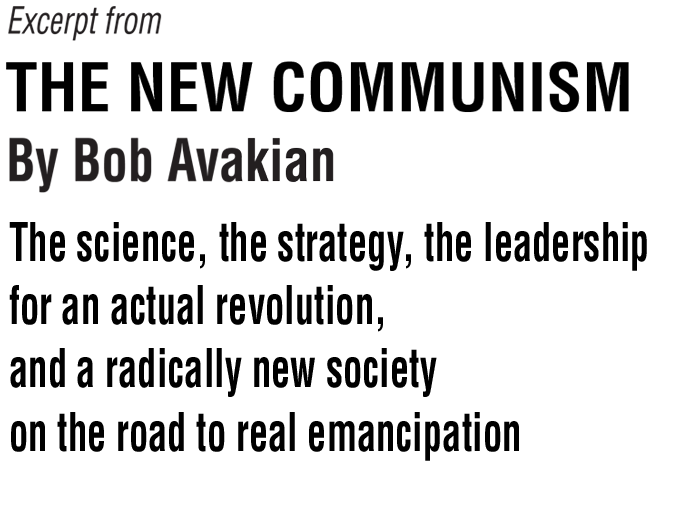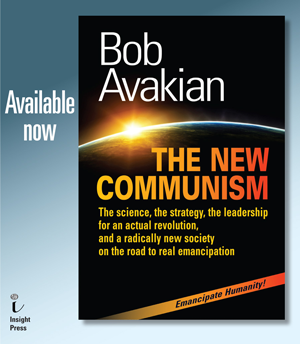
Editors' note: The following is an excerpt from the new work by Bob Avakian, The New Communism. In addition to excerpts already posted on revcom.us, we will be running further excerpts from time to time on both revcom.us and in Revolution newspaper. These excerpts should serve as encouragement and inspiration for people to get into the work as a whole, which is available as a book from Insight Press. A prepublication copy is available on line at revcom.us.
This excerpt comes from the section titled "I. Method and Approach, Communism as a Science."
Excerpt from the section:
Through Which Mode of Production
You know most people, especially if you get into more privileged strata in society, they just think things are there. You go to the grocery store, of course the shelves are full of things. Or you go to a video games store, of course there are video games there. You go to the mall, of course there are all kinds of stores with all kinds of stuff. But where does all this come from? How many people really think about where this comes from and how all this takes place? People just assume these things are going to be there, because somebody else, somewhere else, is doing all the work to produce all those things. And the question: What is the way in which that gets done, what is the mode of production through which all this takes place?—people don’t think about that or have no real understanding about that. But it’s fundamental, if you think about it.
There was a movie made a while ago—I didn’t see it, unfortunately, although people said it maybe wasn’t that great artistically, but it was making an important point. The title of the movie was A Day Without a Mexican. It was making the point: What if all the Mexicans, who are always slandered—and now there are people like Donald Trump aggressively putting out this slander—what if all those Mexicans stopped working for a day? What would happen? Well, you can expand that and say: What if all the people, all over the world, who produce and distribute all these things that people use every day, stopped working for a day or a week or a month? All of a sudden, people would say, “Hey, what the hell’s going on, the shelves are empty!” So this is something that is basic to society, not only that things get produced but how they get produced. What relations do people enter into in carrying out the production of things? In other words, we’re back to the relations of production, what relations people enter into in producing and distributing and transporting these things. Another way to say that, once again, is what’s the mode of production through which all this is done? That sets the basic terms for everything that happens in society. It isn’t everything that happens in society, but it’s the foundation and sets the basic terms for everything that happens in society. If you think about it, that’s pretty obvious, for the same reason that this movie was made. If people stopped producing those things, everything would grind to a standstill.
And if you try to do something in society that’s basically out of line with the mode of production of the existing system, then either you’re going to fail—or you’re going to have to make a revolution. So, more thinking should go on, more work should go on: Why is this true, that through which mode of production is the most important, the most fundamental question—not the only, but the most important and the most fundamental question—to be posed? When you’re taking up any kind of question in society, any form of oppression, anything that you feel needs to be changed, the most fundamental question is what is the mode of production that’s setting the basis and the ultimate terms and the ultimate limits for what can be changed and how?
As I have said, we’ve got to do the work—and, by the way, I’m not gonna do all the work here. A good part of what I’m doing here is posing questions which we’ll dig into, because we all have to do this work, and it’s no good if we have an attitude that somebody else, somewhere else, will do the work and we’ll just follow along. Everybody has to dig in and work on these things. If we are going to be serious, we all have to do this work. Yes, some of us have been at it longer, have more experience and have developed in certain ways to be able to do this, but we all are capable of doing this and we all have to throw in fully and do it. So, an important part of what I’m going to be doing here is posing questions. And this is a big question: Is it true that through which mode of production will any social question, including the oppression of women, be addressed, is the most fundamental question? And why is that true? I said a little bit about that, but I want to throw it out as a question for people to grapple with.
Contents
Publisher's Note
Introduction and Orientation
Foolish Victims of Deceit, and Self-Deceit
Part I. Method and Approach, Communism as a Science
Materialism vs. Idealism
Dialectical Materialism
Through Which Mode of Production
The Basic Contradictions and Dynamics of Capitalism
The New Synthesis of Communism
The Basis for Revolution
Epistemology and Morality, Objective Truth and Relativist Nonsense
Self and a “Consumerist” Approach to Ideas
What Is Your Life Going to Be About?—Raising People’s Sights
Part II. Socialism and the Advance to Communism:
A Radically Different Way the World Could Be, A Road to Real Emancipation
The “4 Alls”
Beyond the Narrow Horizon of Bourgeois Right
Socialism as an Economic System and a Political System—And a Transition to Communism
Internationalism
Abundance, Revolution, and the Advance to Communism—A Dialectical Materialist Understanding
The Importance of the “Parachute Point”—Even Now, and Even More With An Actual Revolution
The Constitution for the New Socialist Republic in North America—
Solid Core with a Lot of Elasticity on the Basis of the Solid Core
Emancipators of Humanity
Part III. The Strategic Approach to An Actual Revolution
One Overall Strategic Approach
Hastening While Awaiting
Forces For Revolution
Separation of the Communist Movement from the Labor Movement, Driving Forces for Revolution
National Liberation and Proletarian Revolution
The Strategic Importance of the Struggle for the Emancipation of Women
The United Front under the Leadership of the Proletariat
Youth, Students and the Intelligentsia
Struggling Against Petit Bourgeois Modes of Thinking, While Maintaining the Correct Strategic Orientation
The “Two Maximizings”
The “5 Stops”
The Two Mainstays
Returning to "On the Possibility of Revolution"
Internationalism—Revolutionary Defeatism
Internationalism and an International Dimension
Internationalism—Bringing Forward Another Way
Popularizing the Strategy
Fundamental Orientation
Part IV. The Leadership We Need
The Decisive Role of Leadership
A Leading Core of Intellectuals—and the Contradictions Bound Up with This
Another Kind of “Pyramid”
The Cultural Revolution Within the RCP
The Need for Communists to Be Communists
A Fundamentally Antagonistic Relation—and the Crucial Implications of That
Strengthening the Party—Qualitatively as well as Quantitatively
Forms of Revolutionary Organization, and the “Ohio”
Statesmen, and Strategic Commanders
Methods of Leadership, the Science and the “Art” of Leadership
Working Back from “On the Possibility”—
Another Application of “Solid Core with a Lot of Elasticity on the Basis of the Solid Core”
Appendix 1:
The New Synthesis of Communism:
Fundamental Orientation, Method and Approach,
and Core Elements—An Outline
by Bob Avakian
Appendix 2:
Framework and Guidelines for Study and Discussion
Notes
Selected List of Works Cited
About the Author
 Download PDF of entire work
Download PDF of entire work